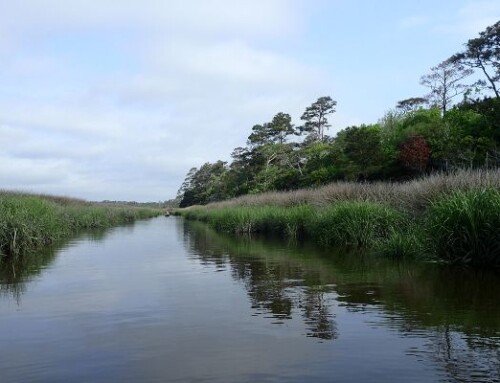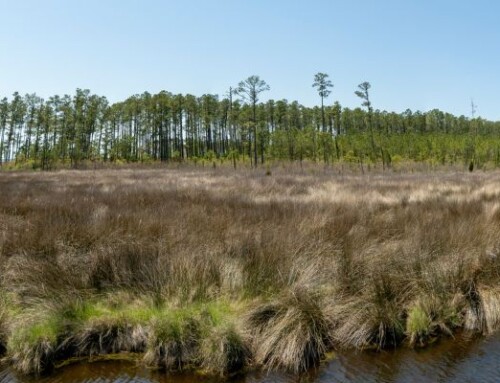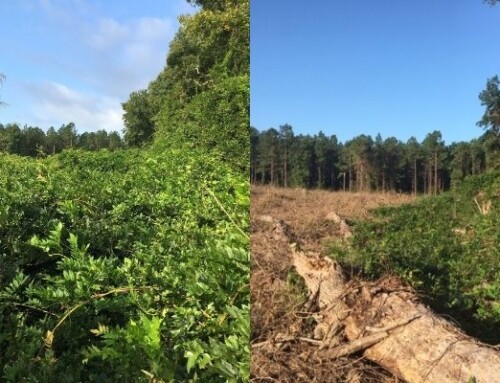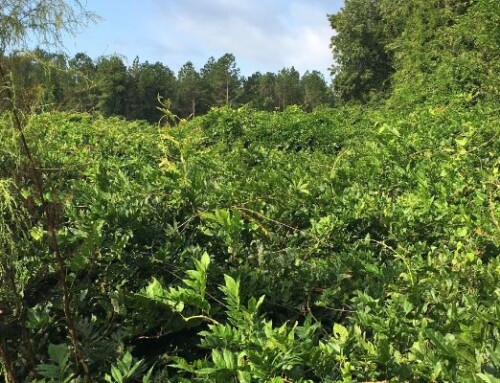“The Flytrap Man” Builds a Garden
How One Person Can Make a Difference
By Shelagh Clancy
[Reprinted with permission from “The ‘Flytrap Man’ Builds a Garden” by Shelagh Clancy, Native Plant News Vol. 20 Issue 1, Spring 2022. Copyright © 2022 North Carolina Native Plant Society.]
Follow a shaded path in the heart of Wilmington, curving among pines and tall magnolias, and you will come upon a sunny open park that’s a unique preserve.
This hidden gem is the Stanley Rehder Carnivorous Plant Garden. It’s home to thousands of indigenous plants: Tiny sundews, a variety of showy pitcherplants, and the famed Venus Flytrap (Dionaea muscipula), native only to a small area within 60 miles of Wilmington.
This garden is the legacy of one man, George Stanley Rehder (1922-2012), who devoted much of his life to studying and preserving carnivorous plants, earning him the nickname “The Flytrap Man.”
“It was his thing,” says Stanley’s daughter Julie Rehder. “He didn’t watch football or drink beer. This is what he loved to do.” His personal fascination with local plants led to the creation of a showcase garden, now a collaborative effort owned privately, managed publicly, and protected by a nonprofit’s conservation easement.
Born to Dig
Plants were Stanley’s heritage. His grandparents emigrated from Germany during the Civil War and his grandmother, Johanna Rehder, grew flowers, Venus Flytraps, and pitcherplants for her own pleasure and for sale to visitors to nearby Oakdale Cemetery. This grew into a florist business which flourished for four generations.
Stanley studied horticulture at North Carolina State College, intending to follow in his family’s footsteps. World War II intervened and he served in the Army’s 66th Infantry Division in France and Germany, earning a Bronze Star. When he returned, he built up the wholesale part of the family business into seven acres of greenhouses. He grew flowers and houseplants while his brother Henry (1911-2004) handled the retail side, selling the greenhouse products.
Stanley’s father Will often took his sons Henry and Stanley on field trips in search of special plants and game. Will, Henry, and Stanley Rehder were lean, lanky men perfectly at home outdoors, fascinated by the plants of southeastern North Carolina. They explored and mapped locations and searched the fields, forests, swamps, and ditches for the carnivorous plants that find a fitting home in the poor soils of the coast.
Finding Flytraps
The Venus Flytrap is a perennial that lives only in pocosin bogs. This “swamp on a hill” environment has sandy soil with underlying peat. It’s usually acid from surrounding pine forest. Carnivorous plants evolved to meet pocosin’s low fertility by capturing insects, which supply the nitrogen lacking in the soil.
Venus Flytraps trap insects with two hinged lobes at the end of each leaf, which close when internal hairs are stimulated several times, a fascinating trick that entrances children, adults, and theatergoers. Flytraps can live up to 20 years in the wild and reproduce by seed, sending up white flowers May through June, when they are easier to spot. Because the plant is less than six inches across, they can be hard to see unless you’re looking for them.
The Venus Flytrap appeals to everyone—and grows only in a rapidly-changing coastal environment.
“My dad started seeing land being bought up,” Julie says. As development grew, Stanley turned his eye toward protecting this small, easy-to-overlook plant. He collected seeds, replanted threatened specimens, and spread the word about this tiny treasure.
“Since the 1960s and 70s, he has called the Star News to suggest stories to build up interest. He ferried visitors from around the world to see his special plants in the wild. He lobbied legislators for protections.” He became known as The Flytrap Man.
In the 1970s and 80s, his campaign got national attention. He appeared on Good Morning America, The Today Show, and That’s Incredible, and when Barbara Walters interviewed him, he shocked her by pulling out a palmetto bug: food for his carnivorous plants.
Stanley later moved to a career in commercial real estate, but his eye for plants didn’t falter. He was still searching the land for flytraps. In the 1960s, while the area south of Oleander Drive was being developed by Hugh McRae and the Oleander Company, Stanley noticed a section that was passed over, too wet for building. But not too wet for flytraps.
“The flytraps were on the banks,” Julie says. “He knew the roadbed that was cut out was ready for flytraps. It had the perfect setup: moisture, sun, and poor soil. Hugh McRae was a friend, and my dad asked if he could build a garden there.” The answer was yes.
A Garden Is Born
Stanley began by planting seeds from plants along the side of the road toward the center. He laid out stone steps meandering through the sunny site and began collecting specimens of other carnivorous plants and planting them in the narrow slice of land behind Alderman School. For more than 20 years, with the McRae family’s permission, he sowed seeds and plants and tended the site. He even set up a box of brochures.
The garden grew and visitors arrived by word of mouth. The Alderman students cherished it and those in the know could visit this densely-populated, curated garden where carnivorous plants were collected for display and education. But the garden was not yet formally shared with Wilmington. Friends in the community stepped in to help.
“Camilla jumped in and harnessed some of my dad’s enthusiasm,” Julie says. Camilla Herlevich, founder of the Coastal Land Trust, saw the need to make Stanley’s garden official. She worked out a plan: The Oleander Company would retain ownership and lease the garden to the City of Wilmington, which would manage it in partnership with the land trust. The land trust’s conservation easement permitted limited development.
“The Land Trust wanted to make sure people could visit and appreciate Stanley’s vision for years to come,” says Jesica Blake, Coastal Land Trust Director of Stewardship and Community Conservation.
Now the three-quarter-acre garden took on a more formal status. The city added parking and a pervious, accessible path leading to wooden observation decks that overlook a sea of sundews, pitcherplants, bladderworts, butterworts, and Venus Flytraps. Signage identifies both carnivorous plants and the surrounding flora, such as Wiregrass and Longleaf Pine. The Stanley Rehder Carnivorous Plant Garden was dedicated in 2012.
“It never ceases to amaze me,” says Jesica. “The Carnivorous Plant Garden is an experience Wilmington has to offer to people from all over the world. It is so unique.” The Coastal Land Trust invites the public to its annual celebration, the Flytrap Frolic, June 4 at the garden. [ed. note: no charge, but sign-ups are required]
Now You See It—Now You Don’t
Venus Flytrap is rapidly declining in its native range from pressures of habitat loss, development, fire suppression, agriculture, pollution, and poaching. In 1958, a survey found 259 documented sites where flytraps grow in North and South Carolina. As of 2016, only 71 sites remain. It has disappeared from Moore, Robeson, and Lenoir counties, and in South Carolina, from the coastal counties of Charleston and Georgetown. The species is under federal Endangered Species Act review. The State of North Carolina lists Dionaea muscipula as Special Concern–Vulnerable.
“Camilla has done a lot to protect flytraps in Camp LeJeune,” Julie says. “The garden is a showcase, but the real plants are in the wild. That’s why I put the Coastal Land Trust in my will.”
Many thanks to Julie Rehder of Therapeutic Musicians of Coastal Carolina and former public relations specialist at the Davis Community, and to Jesica Blake, Associate Director and Director of Stewardship and Community Conservation at the Coastal Land Trust.
Shelagh Clancy is a member of the Southeastern Coastal Area Chapter of the North Carolina Native Plant Society and is active with the Coastal Land Trust, which preserves land along North Carolina’s coast. She is a freelance editor and designer and owner of Sea Leaf Book Services (sealeafbooks.com).
Original story published online here:
https://ncwildflower.org/flytrap-man
Featured image: Julie Rehder and her father, the late Stanley Rehder, attend the dedication of the Stanley Rehder Carnivorous Plant Garden in 2012.






